Scottish Crime and Justice Survey 2016/17: main findings
This report details the main findings from the Scottish Crime and Justice Survey conducted 2016-2017.
This document is part of a collection
3. Focus on violent crime
What was the extent and prevalence of violent crime in Scotland in 2016/17?
There were an estimated 231,000 violent crimes experienced by adults in 2016/17, representing about a third of all crime.
The Scottish Crime and Justice Survey estimates that 231,000 violent crimes were experienced by adults in Scotland in 2016/17 [11] [12] . This figure accounts for 32% of all crime measured by the SCJS in 2016/17, with the remainder being property-related.
As a sample survey of the general public, SCJS results are estimated values with margins of error around them, rather than exact counts. Further information on the process used to calculate estimates is contained within the Technical Report. Taking into account these confidence intervals, the SCJS estimates that there were between 172,000 and 290,000 incidents of violent crime in Scotland in 2016/17. The following analysis is focused on the best estimates for each sweep of the survey.
The level of violent crime in Scotland has fallen by more than a quarter since 2008/09.
Figure 3.1 displays the number of violent incidents estimated to have taken place by each sweep of the SCJS since 2008/09, and shows a downward trend over the longer-term [13] .
Figure 3.1: Estimated number of violent incidents, 2008/09 - 2016/17
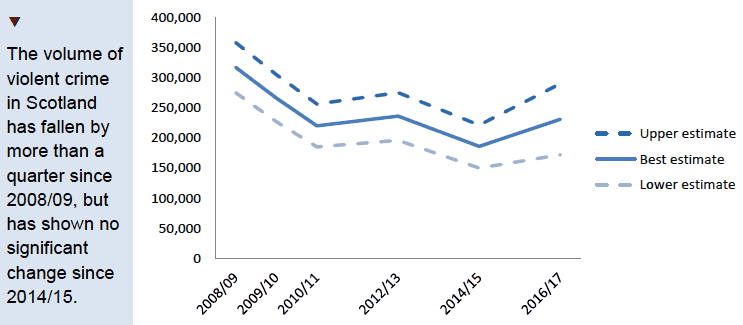
Base: SCJS 2008/09 (16,000); 2009/10 (16,040); 2010/11 (13,010); 2012/13 (12,050); 2014/15 (11,470); 2016/17 (5,570). Variable: INCVIOLENT
Table 3.1 examines results from key comparator years [14] more closely and shows that the estimated amount of violent crime experienced by adults:
- fell by 27% between 2008/09 and 2016/17 from 317,000 to 231,000 incidents;
- has shown no real change since the last SCJS in 2014/15 – the apparent increase from 186,000 violent incidents in 2014/15 is not statistically significant.
Table 3.1: Estimated of number of violent crimes (2008/09, 2014/15, 2016/17)
| Number of violent crimes | 2008/09 | 2014/15 | 2016/17 | Change since 2008/09 | Change since 2014/15 |
|---|---|---|---|---|---|
| Best estimate | 317,000 | 186,000 | 231,000 | ⇩ by 27% | No change |
| Lower estimate | 275,000 | 150,000 | 172,000 | ||
| Upper estimate | 358,000 | 221,000 | 290,000 | ||
| Number of respondents | 16,000 | 11,470 | 5,570 |
Base: SCJS 2008/09 (16,000); 2014/15 (11,470); 2016/17 (5,570). Variable: INCVIOLENT
Violent crime estimates derived from the SCJS are based on a relatively small number of respondents who disclose experiences of such issues in the survey in any given year [15] . As a result, analysis of findings between adjacent surveys are often less likely to identify statistically significant changes. However, where they exist, the SCJS can often identify significant changes and trends over the longer-term (such as since 2008/09).
The likelihood of experiencing violent crime is relatively small and has fallen significantly since 2008/09 alongside a reduction in the number of incidents.
In line with survey results in previous years, the vast majority of adults in Scotland did not experience violent crime in 2016/17. The SCJS estimates that 2.9% of adults were victims of at least one violent crime in 2016/17. In comparison, an estimated 11.5% of adults experienced property crime in 2016/17.
As with incident numbers, crime prevalence rates are also estimates with associated margins of error around them as they are derived from a sample survey of the population. Taking into account these confidence intervals, between 2.3% and 3.4% of the adult population were estimated to have experienced violent crime in 2016/17, with 2.9% representing the best estimate [16] . Again, as with incident counts, analysis from this point onwards will focus on the best estimates for results across the survey for each sweep [17] .
Looking at trends over time, the proportion of adults experiencing violent crime has fallen from 4.1% in 2008/09 to 2.9% in 2016/17. Overall, this suggests that violent crime victimisation in Scotland has been relatively uncommon over recent years and is becoming a rarer experience still.
That said, since the last SCJS in 2014/15 there has been no real change detected in the proportion of the adults experiencing violent crime. The apparent increase from 2.6% in 2014/15 to 2.9% in 2016/17 is not statistically significant, as noted in Figure 3.2. This reflects the finding that the estimated number of violent incidents has also shown no change since 2014/15, however as noted above, the SCJS is often better able to identify trends and changes, where they exist, over longer time periods.
Figure 3.2: Proportion of adults experiencing violent crime by year
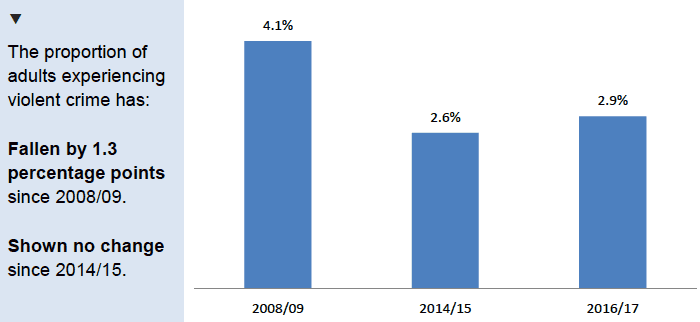
Base: SCJS 2008/09 (16,000); 2014/15 (11,470); 2016/17 (5,570). Variable: PREVVIOLENT
What types of violent crime were most commonly experienced in 2016/17?
The majority of violent crimes in 2016/17 were incidents of minor assaults resulting in no or negligible injury.
Almost three-quarters of violent incidents in 2016/17 (72%) were cases of minor assault with no or negligible injury to the victim, as shown in Figure 3.3.
By comparison, fewer than one in ten violent incidents (7%) in 2016/17 were serious assaults, whilst less than one in twenty (3%) were robberies. Taken together, all categories of assault accounted for 97% of violent crime.
Figure 3.3: Categories of crime as proportions of violent crime overall
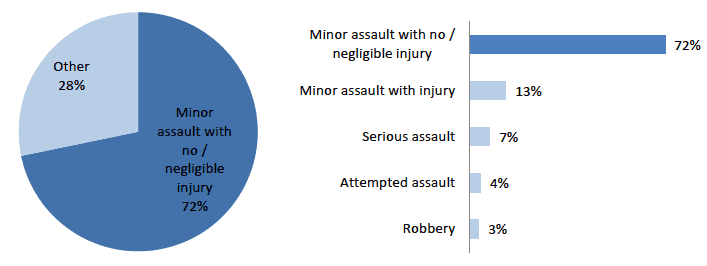
Base: 2016/17 (5,570). Variable: INCSERASSAULT, INCMINORASSINJURY, INCMINORASSNOINJURY, INCATTEMPTASSAULT INCROB.
Whilst assaults continue to be the most common form of violence experienced, the number of incidents and proportion of adults affected has fallen greatly since 2008/09.
Considering the two main categories of violent crime (assault and robbery) the SCJS finds that there have been notable reductions in the number of incidents across both groups since 2008/09 – leading to decreases in violent crime overall. For instance, as shown in Table 3.2, it is estimated that there were almost 75,000 fewer assaults in 2016/17 than in 2008/09. The estimated number of robberies has more than halved over this period [18] .
Table 3.2: Estimated number of incidents of types of violent crime
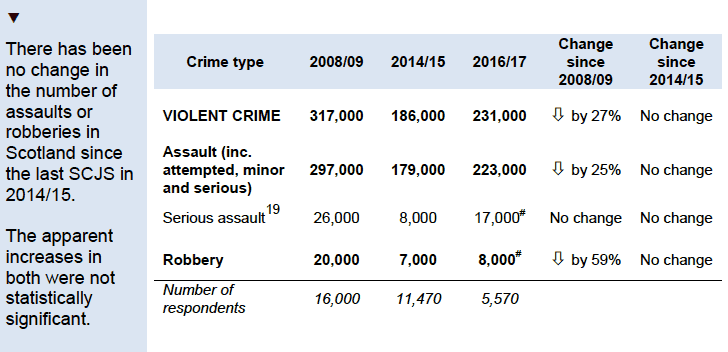
Variables: INCVIOLENT; INCASSAULT; INCSERASSAULT; INCROB.
#: Use with caution – the estimate has a relative standard error of greater than 20%.
As in previous years, the prevalence rate for different categories of violent crime varied greatly in 2016/17. Despite still being a relatively rare experience, adults were around fourteen times more likely to have been victims of assault in 2016/17 than robbery (experienced by 2.8% and 0.2% respectively), as shown in Figure 3.4.
Examining trends over time, the SCJS finds that the prevalence of assault fell between 2008/09 and 2016/17 from 3.8% to 2.8%, whilst the likelihood of experiencing robbery did not show any significant change over the same period [20] .
Figure 3.4: Proportion of adults experiencing types of violent crime, 2008/09 – 2016/17
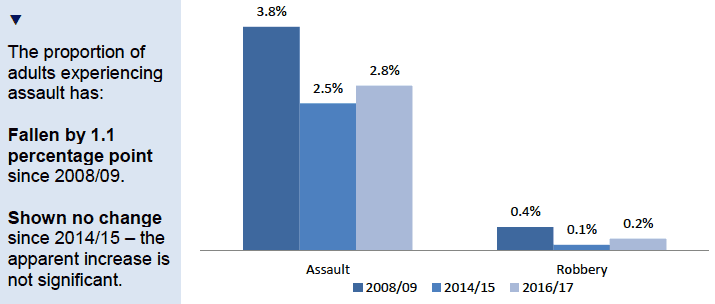
Base: SCJS 2008/09 (16,000); 2014/15 (11,470); 2016/17 (5,570). Variables: PREVASSAULT; PREVROB.
Whilst a small proportion of adults were victims of any sort of violence in 2016/17, experiences of more serious forms of violence were rarer still. This is in line with the finding that the vast majority of violent crime was accounted for by minor assaults. For instance, a greater proportion of adults experienced minor assault with no or negligible injury (2.0%) than minor assault resulting in injury (0.4%) or serious assault (0.2%).
How did experiences of violent crime vary across the population?
Younger adults, people in the most deprived areas of Scotland and those living in urban locations were more likely to be victims of violent crime in 2016/17.
The SCJS enables us to examine how experiences of violent crime varied across the population by demographic and geographic characteristics. As shown in Figure 3.5, and similar to property crime, the likelihood of being a victim of violent crime in 2016/17:
- Decreased with age;
- Was greater for those living in the 15% most deprived areas in Scotland; and
- Was greater for adults living in urban locations.
Unlike results in previous years, the SCJS did not detect a significant difference in the proportion of males and females who experienced violent crime in 2016/17 (3.4% and 2.3% respectively) [21] .
Figure 3.5: Proportion of adults experiencing violent crime, by demographic and area characteristics
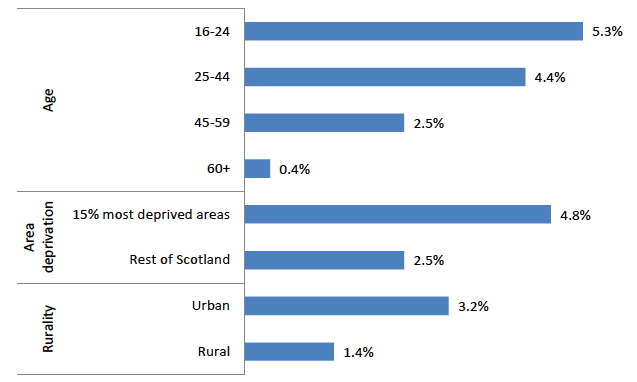
Base: 2016/17 (5,570). Variable: INCSURVEYCRIME, QDAGE, SIMD_TOP, URBRUR.
Examined in more detail, these results show that just over 1 in 20 adults aged 16-24 (5.3%) were victims of violent crime in 2016/17, compared to around 1 in 200 of those aged 60 and over (0.4%). Looking at area deprivation, those living in the 15% most deprived areas were almost twice as likely to experience violent crime in 2016/17 as those living in the rest of Scotland.
The proportion of younger adults experiencing violent crime has more than halved since 2008/09, but similar improvements have not been experienced by all groups over this period.
Considering trends in victimisation over time, the SCJS finds that since 2008/09 changes in the prevalence of violent crime have not been experienced evenly across the population. For example, Figure 3.6 shows the differing trends experienced by different age groups between 2008/09 and 2016/17.
Figure 3.6: Proportion of adults experiencing violent crime by age over time
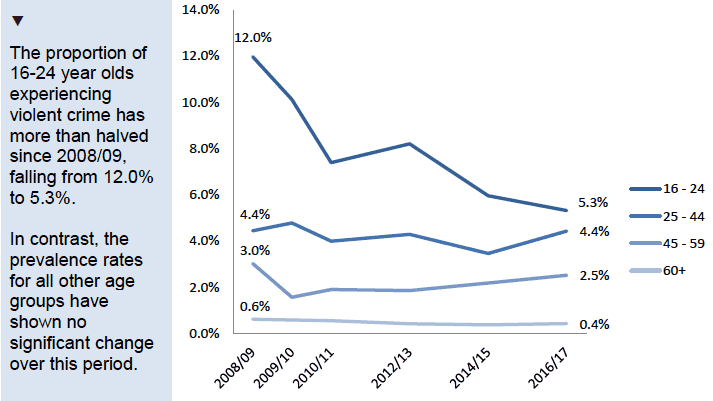
Base: SCJS 2008/09 (16,000); 2009/10 (16,040); 2010/11 (13,010); 2012/13 (12,050); 2014/15 (11,470); 2016/17 (5,570). Variable: PREVVIOLENT, QDAGE.
That said, while trends in the victimisation rate have varied by different age groups since 2008/09, younger adults remained the group most likely to have been victims of violence in 2016/17.
Examining changes in the victimisation rate since 2008/09 for other demographic and geographic breakdowns [22] reveals:
- the likelihood of experiencing violence has decreased for those living in urban areas (from 4.6% to 3.2%), but has shown no change in rural areas;
- the proportion of males experiencing violent crime has fallen by 2.3 percentage points (from 5.7% to 3.4%), but the prevalence rate for females has shown no change; and
- the prevalence rate for adults living in the 15% most deprived areas has not shown any significant change since 2008/09, whereas the rate has reduced for those living in the rest of Scotland (from 3.8% to 2.5%).
Since 2014/15, in line with the national average, there has been no statistically significant change in the violent crime victimisation rate across any of these key sub-population groups.
What can the SCJS tell us about repeat victimisation?
The SCJS estimates that most adults did not experience violent crime in 2016/17, whilst 2.9% of the population were victims of at least one violent crime. However, the survey also enables us to further explore how experiences varied amongst victims and examine the concentration of crime, including what proportion of victims experienced a particular type of crime more than once during the year [23] , known as 'repeat victimisation'.
Further information about the approach taken to process and derive SCJS results, including on repeat victimisation, is provided in the Technical Report.
Relatively few adults suffered from repeat victimisation in 2016/17, but their experiences accounted for two-thirds of all violent crime.
Table 3.3 explores the volume of crime experienced by victims in more detail to outline the extent of repeat victimisation and further unpack the concentration of violent crime amonst the adult population. It reveals that 1.8% of adults were victims of a single violent incident over the year, with a smaller proportion of the population (1.1%) experiencing repeat victimisation (two or more violent crimes). These repeat victims are estimated to have experienced on average three violent crimes each during 2016/17, whilst together this group of adults are estimated to have experienced two-thirds (66%) of all violent crime committed against adults over this period. The table also highlights that an even smaller proportion of the population (0.3%) were high frequency repeat victims experiencing five or more incidents each.
Table 3.3: Proportion of violent crime experienced by repeat victims, by number of crimes experienced (2016/17)
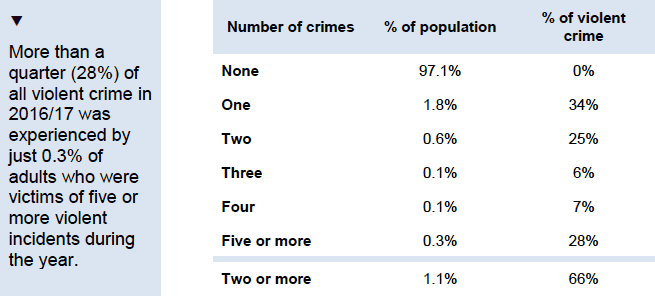
Base: SCJS 2016/17 (5,570). Variable: PREVVIOLENT, INCVIOLENT.
The SCJS has not detected any change in the proportion of adults experiencing repeat and high frequency repeat violent crime victimisation since 2008/09.
Figure 3.7 shows trends in single and repeat violent crime victimisation over time. It highlights that the proportion of adults experiencing only one incident of violence fell between 2008/09 and 2016/17 (from 2.6% to 1.8%). In contrast, notwithstanding the difficulties associated with identifying significant changes for relatively rare experiences [24] , since 2008/09 the SCJS has detected no change in the proportion of adults experiencing:
- repeat victimisation (two or more incidents of violence) – the apparent decrease from 1.6% to 1.1% is not significant;
- or high frequency repeat victimisation (five or more incidents of violence) – which had a prevalence rate of 0.3% in each year.
Figure 3.7: Proportion of adults experiencing number of violent crimes
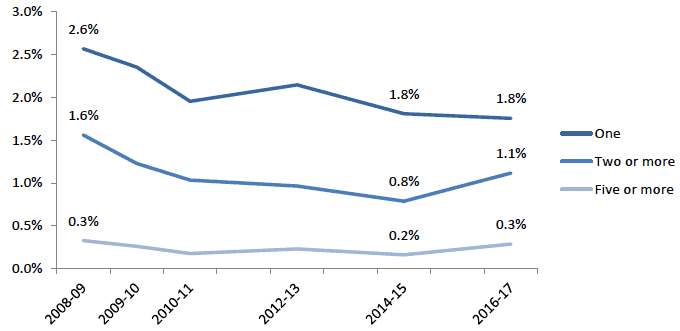
Base: SCJS 2008/09 (16,000); 2009/10 (16,040); 2010/11 (13,010); 2012/13 (12,050); 2014/15 (11,470); 2016/17 (5,570). Variable: PREVVIOLENT, INCVIOLENT.
All levels of violent crime victimisation have shown no change since 2014/15.
The SCJS estimates that the proportion of adults experiencing at least one incident, one incident specifically, and two or more incidents of violent crime did not change between 2014/15 and 2016/17 - the apparent differences shown in Figure 3.7 are not statistically significant.
What were the characteristics of violent crime?
Nearly three-quarters of violent crime took place in public settings in 2016/17.
When locations are combined into broader categories, the SCJS estimates that just under three-quarters of violent incidents in 2016/17 (73%) occurred in a public setting, with the remainder taking place in a private space [25] .
Figure 3.8 looks at particular locations more closely and demonstrates that violent crime was experienced in a variety of settings in 2016/17, with the respondent's place of work (28%) the most commonly cited specific location.
Figure 3.8: Proportion of violent crime incidents occuring in different locations
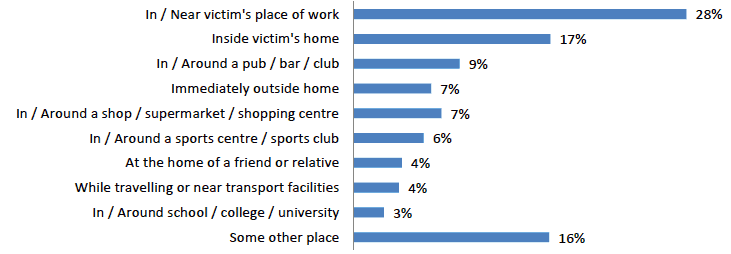
Base: Violent crime incidents (160); Variable: QWH1 / QWH3 / QWH5 / QWH7
The proportion of violent incidents estimated to have taken place in or around a pub or bar has fallen from 18% in 2008/09 and 17% in 2014/15 to 9% in 2016/17.
Although a higher proportion of violent crimes took place during the week, the incidence per day was greater at weekends.
Where respondents provided details about when an incident occurred [26] , just over half of violent crime incidents (54%) happened during the week, with 46% taking place at weekends [27] . However, taking into account the number of days within each category means that the incidence of violent crime per day was higher at weekends.
What do we know about perpetrators of violent crime?
In 87% of violent crime incidents reported in 2016/17, respondents were able to provide some information about the offender [28] . The section below presents headline results on the details provided [29] . All findings are proportions of cases where respondents were able to say something about the person or people who carried out the offence, unless stated otherwise.
More than four in five violent crimes were committed by male offenders.
The SCJS results highlight that the vast majority of violent crimes in 2016/17 (84%) were carried out by males only – a consistent finding over the years.
Violent incidents most commonly involved offenders under the age of 40.
Figure 3.9 shows that violent crimes involved people from a range of age groups, but only around one in four incidents involved any offenders over the age of 40, suggesting that perpetrators tend to be from younger cohorts [30] . That said, the proportion of cases involving offenders aged 40 and over has increased from 12% in 2008/09.
Figure 3.9: Percentage of violent crime incidents involving offenders of each age group
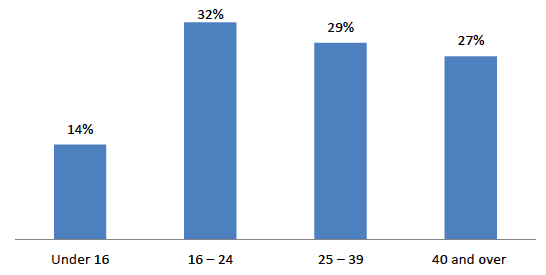
Base: Violent crime incidents where respondent could say something about offender (140); Variable: QAGE
Violent crimes often involved offenders who victims knew or had seen before.
Most incidents (71%) in 2016/17 were committed by people who the victims knew or had seen before. Where offenders were known by the victim, four out of five incidents (79%) were said to have involved people 'known well'.
What do we know about the role of alcohol and weapons in violent crime?
The proportion of violent crimes involving offenders under the influence of alcohol has fallen from just over three-in-five in 2008/09 to around two in five in 2016/17.
Offenders were believed to be under the influence of alcohol in just over two-fifths (42%) of violent crime incidents where victims were able to say something about the offender in 2016/17. As Figure 3.10 shows, this proportion has decreased significantly over recent years.
Figure 3.10 [31] : Proportion of violent crime offenders under the influence of alcohol
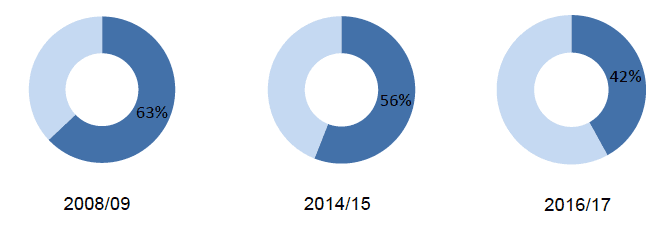
Base: Violent crime incidents where respondent could say something about offender (140); Variable: QAL
These findings coupled with a decline in the number of incidents said to have taken place in and around pubs and bars may suggest that alcohol is decreasing in prominence as a factor in violent crime overall – although it remains a factor in a sizeable proportion of incidents. It will be important to monitor these results into the future. For context, in relation to all incidents of violent crime in 2016/17, victims reported having consumed alcohol immediately before the incident in 22% of cases.
Relatedly, victims reported that just over one in five violent crimes (22%) involved offenders who were thought to be under the influence of drugs in 2016/17.
Violent crime in 2016/17 did not commonly involve the presence or use of weapons.
Victims who said that someone saw or heard what was going on (96% of violent incidents) were asked additional questions about their experience, including the presence of weapons. 15% of such incidents [32] in 2016/17 were said to have involved perpetrators with weapons; no change was detected since 2010/11 (when this wording of this question was updated). A knife was reported as being present in 6% of violent incidents where someone saw or heard what was happening.
What was the impact of violent crime?
Three-fifths of violent incidents resulted in injury, although serious injuries were relatively rare.
Where violent crime resulted in injury (59% of incidents), the most common injuries sustained in incidents were minor bruising or a black eye (57%%) and scratches or minor cuts (31%). More serious injuries like head injuries and broken bones occurred much less frequently, as shown in Figure 3.11 [33]
Figure 3.11: Type of injuries sustained as a proportion of violent incidents resulting in injury
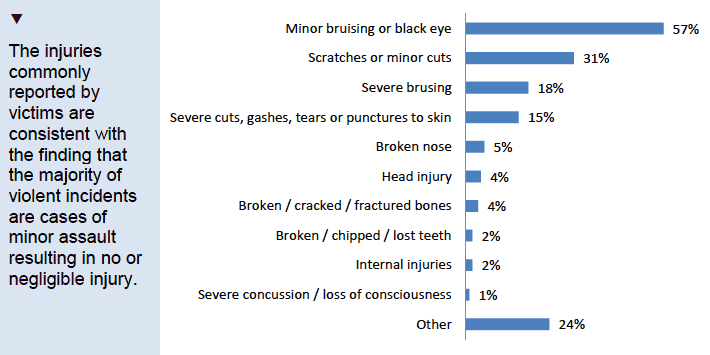
Base: Violent crime incidents where respondent was injured (80); Variable: QINW
Anger, annoyance and shock were the most common emotional reactions to violent crime.
Consistent with previous years, the emotional impacts most commonly reported by victims of violent crime in 2016/17 were anger (reported in 52% of violent incidents), annoyance (51%) and shock (50%).
Victims of violent crime were also more likely than victims of property crime to experience other strong negative emotional responses such as feeling depressed, losing confidence and having difficulty sleeping. For instance, 28% of violence victims said they had lost confidence or felt vulnerable compared to 12% of property crime victims.
What proportion of violent crime was reported to the police?
Most violent incidents in 2016/17 were not considered to be crimes by the victims and more than half were not reported to the police.
The 2016/17 SCJS estimates that just over two-fifths of violent crime incidents (43%) were brought to the attention of the police. The reporting rate in 2016/17 was similar to that in both 2008/09 and 2014/15 (43% and 44% respectively), and not significantly different from the report rate for property crime in 2016/17 (34%).
There can be a range of factors which influence whether or not an individual reports an issue to the police, not least how the victim views their own experience. For instance, the SCJS finds that in just over two-fifths of violent crime incidents in 2016/17 (43%) victims thought their experience should be described as 'a crime' as shown in Figure 3.12 below. Almost two-thirds (64%) of incidents which victims considered to be a crime were brought to the attention of the police in 2016/17.
Figure 3.12: Victim's description of violent crime incidents experienced
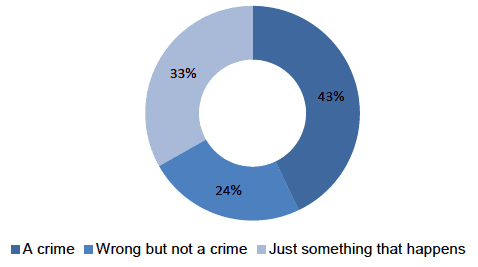
Base: Violent crime incidents (160); Variable: QCRNO
When asked directly why they did not report their experience, as in previous years, victims cited a range of reasons. The most common explanations provided by victims were that:
- they dealt with the matter themselves (47% of unreported violent crime incidents);
- the issue was considered a private, personal or family matter (24%);
- the matter was reported to other organisations or authorities (21%); or
- the experience was too trivial or not worth reporting (21%).
Where incidents did come to the attention of the police, victims received information or assistance about the investigation and the case (where relevant) from the police in about a third of instances (32%). In just under a quarter of such incidents (23%) respondents received information or assistance from the Witness Service/Victim Support Scotland, and from the Crown Office and Procurator Fiscal Service in slightly more than a tenth (12%). In a little over a third of cases (35%) victims said they had not received information or assistance from any organisation.
What consequences did victims believe offenders should have faced?
Most violent crime victims did not think the offender should have gone to court, but views varied greatly on what action would have been appropriate.
Regardless of whether the incident was reported to the police, victims in just under two-fifths (39%) of all violent crime thought the offender should have been prosecuted in court. This proportion has fallen from 52% in 2008/09, and is lower than the proportion of property crime victims in 2016/17 who thought offenders should have been prosecuted in court (52%).
More than two-fifths (42%) of those who did not think court was appropriate said nothing should have happened to the offender, whilst 23% thought they should have been made to apologise for their actions. On the other hand, half (50%) of those who thought the offender should have gone to court believed they should have received a prison sentence.
Contact
There is a problem
Thanks for your feedback